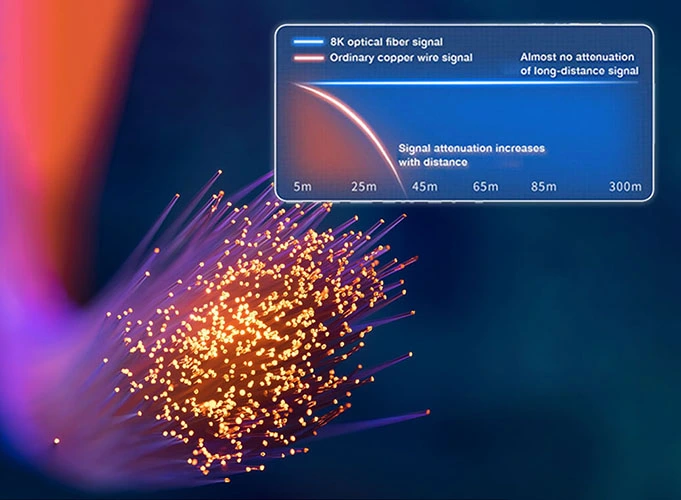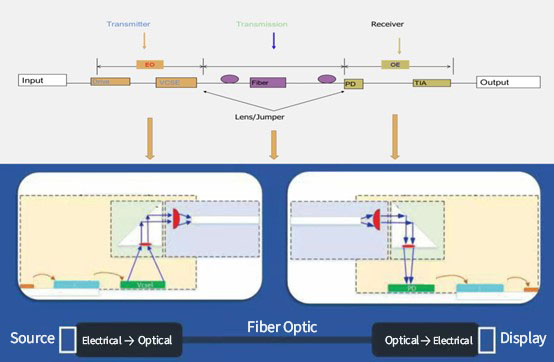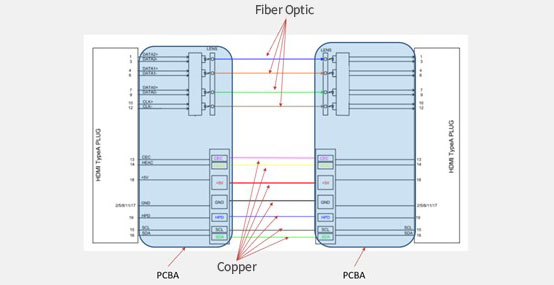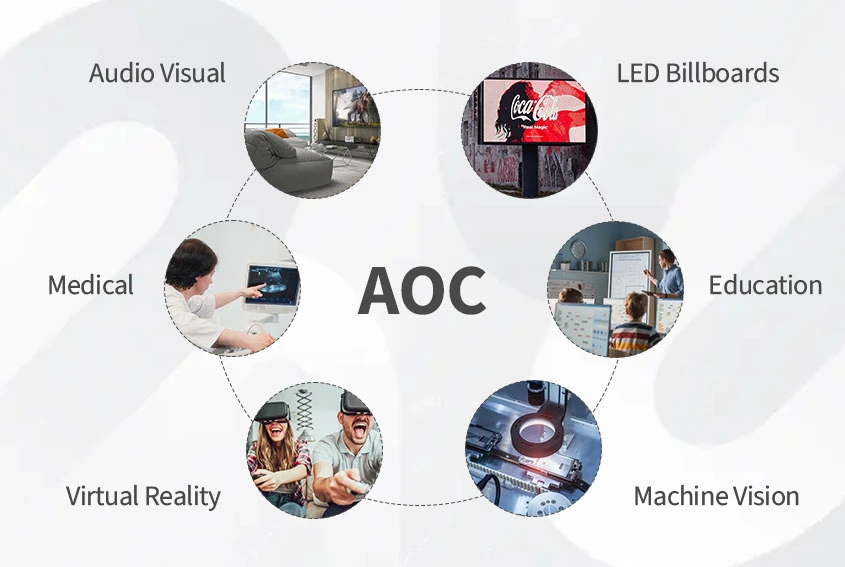AOCFiberLink is a technology-based, customer-oriented company that has been focusing on the development and innovation of integrated electronic and optical signals for more than 20 years. Since 2003, we have been customizing excellent connection solutions for our customers and continue to provide quality services to our customers. Our active hdmi 2.1 cable have obtained CE and ISO9000 certifications, and all active optical cables are RoHS compliant.

HDMI active optical cable combine AOC+ technology to break through the limitations of traditional copper cables, with high-speed and long-distance transmission capabilities without attenuation, anti-electromagnetic interference, light weight, higher security and lower heat generation. This makes it perform well in environments such as ultra-high-definition audio and video and ultra-high-speed data long-distance transmission.
AOC is the abbreviation of Active Optical Cable. AOC is a transmission cable that carries electro-optical conversion chips and photoelectric conversion chips and transmits high-speed signals through optical fibers.
AOC integrates optical chips, high-speed electrical chips, optical lenses, RF connectors and other components to complete the functions of EO/electrical to optical and OE/optical to electrical, and realize signal transmission in optical fiber media. It adopts direct modulation and direct detection technology to realize electro-optical modulation and optoelectronic demodulation through 850nm VCSEL and PIN optical chips.

Taking HDMI as an example, let's briefly introduce the principle of optoelectronic conversion. Generally, signals that need to be transmitted by light are high-speed signals. First, the source end receives the electrical signal, converts it into an optical signal, and transmits it to the Display end through a long-distance optical fiber. The Display end converts the received optical signal into an electrical signal and transmits it to the back-end device to realize high-speed signal transmission. As for basic functions such as communication handshake, copper wire transmission is used for implementation.

Active optical cables, embedded with signal amplifiers and converters, provide high bandwidth and long-distance data transmission. They support 4K and 8K video in home theaters, ensure stable transmission for telemedicine and imaging in healthcare, and enhance multimedia interaction in education. In virtual reality, these fiber optical hdmi cable improve user experience with low latency, support efficient automation in machine vision, and ensure clear video display on LED billboards, highlighting their crucial role in modern technology.




 What are active optical cables?
What are active optical cables?
Active optical cable (AOC) is a fiber optic cable with integrated electronic components. The transmitting end converts electrical signals into optical signals and transmits them through optical fibers, and converts them back into electrical signals at the receiving end. Optical fiber hdmi can support high-speed, long-distance data transmission while maintaining signal integrity and almost zero attenuation. The advantage of AOC is that it combines the high bandwidth and low latency characteristics of optical fibers, making it suitable for applications that require high-performance, long-distance transmission.
 What is the difference between active and passive optical cable?
What is the difference between active and passive optical cable?
There are significant differences between active optical cables (AOCs) and passive optical cables in terms of structure and function. AOCs use optical fiber for connection, and although it accepts the same electrical input as standard copper cables, it greatly enhances the transmission speed and range of the signal by performing electrical-optical conversion at both ends of the connection. This enables AOCs to maintain high-quality signal transmission over long distances, making them suitable for scenarios that require high performance and long-distance transmission.
In contrast, passive optical cables are pure signal conduits and do not contain any electronic components for signal enhancement, so signal attenuation and quality degradation may occur over long distances.
 What is the difference between an AOC and DAC cable?
What is the difference between an AOC and DAC cable?
Direct Attach Copper Cables (DACs) are made of copper cables and are available in two types: passive and active. Passive DACs do not require signal conditioning, so they have low power consumption and low production costs, making them ideal for short-distance applications, typically up to 10 meters in length. Active DACs have built-in electronics to boost the signal, allowing for slightly longer distances, up to 15 meters.
In contrast, Active Optical Cables (AOCs) are made of multimode fiber and convert electrical signals to optical signals with the need for external power, making them suitable for transmissions up to 100 meters, and even 300 meters with pure fiber, with transmission rates up to 48G. Although AOCs are generally more expensive than DACs, they have a clear advantage in eliminating electromagnetic interference (EMI) because optical fiber is not affected by EMI. DACs are an economical choice for short-distance, low-power connections, while AOCs are a more ideal choice when long-distance, high-speed transmission and EMI protection are required.
 What is the difference between MPO and AOC cable?
What is the difference between MPO and AOC cable?
MPO fiber patch cords and AOC fiber patch cords are significantly different in their uses and structures. MPO fiber patch cords utilize multi-core design and MPO connectors, and are designed for high-density fiber networks, greatly improving the efficiency and density of wiring in data centers, high-performance computing, and telecommunication networks. They support high-speed data transmission and can be deployed quickly.
AOC fiber patch cords combine the advantages of optoelectronic conversion and optical fiber, and achieve long-distance, high-speed data transmission between two terminals through built-in optoelectronic conversion chips. With its low power consumption, lightness, and strong anti-interference ability, AOC is particularly suitable for internal connections in data centers, high-performance computing, and transmission needs between ultra-high-definition display devices. AOC is seen as a highly promising option, while MPO continues to play a key role in high-density application environments.
 What is AOC in HDMI cable?
What is AOC in HDMI cable?
AOC HDMI cable (Active Optical Cable HDMI) uses optical fiber technology to transmit data. Compared with traditional copper cable HDMI, it can maintain the integrity of high-resolution signals over longer distances, usually up to 100 meters or up to 300 meters in the case of pure optical transmission without signal attenuation. This cable supports high-bandwidth and high-speed data transmission with a bandwidth of up to 48Gbps, suitable for video and audio transmission with 4K@144Hz and 8K@60Hz resolutions. It also has a lighter and more flexible design and is easy to install. Due to the transmission of optical signals, AOC HDMI cables are immune to electromagnetic interference (EMI) and provide stable and reliable signal quality. They are particularly suitable for use in occasions that require high-quality long-distance transmission, such as large home theaters, commercial displays, outdoor activities, or digital signage.
 What is a USB optical cable?
What is a USB optical cable?
Active Optical USB Cable transmits USB signals through optical fiber technology, which can achieve high-speed data transmission up to 100 meters over distances exceeding traditional copper cables without affecting signal quality. The optical fiber material makes it lightweight, flexible, easy to install, and has the advantage of anti-electromagnetic interference, ensuring signal stability in multi-device environments. These cables may require additional power support, usually provided through the USB connection or external power supply. USB optical fiber cables are very suitable for industrial environments or situations where long-distance high-speed data transmission is required to ensure data integrity and transmission speed.
Whether you are interested in AOCFiberLink's products or have any other questions, we are always happy to help you understand the products and answer your questions.